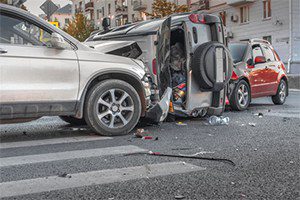
The 3-Collision Rule The occupants of a vehicle involved in an accident suffer three separate collisions. The first collision is the car in which a person is riding strikes another object. The body subsequently collides with an object in the vehicle. That object could be the seat belt, airbag, steering wheel, dashboard, windshield, doors or […]

The 3-Collision Rule
The occupants of a vehicle involved in an accident suffer three separate collisions. The first collision is the car in which a person is riding strikes another object. The body subsequently collides with an object in the vehicle. That object could be the seat belt, airbag, steering wheel, dashboard, windshield, doors or pillar. There could be an intervening collision before the final collision in that a person could be ejected from the vehicle or off of a motorcycle. The final collision occurs within the body. The organs in the body get violently thrown around inside the body. For instance, the brain slams up against the skull, then recoils to hit the opposite side of the skull upon contact.
One of the most common internal injuries that turn out to be fatal occurs when the aorta twits and ruptures. The second collision, described above, with a seat belt or airbag creates a significant deceleration within the body. One theory as to why an aorta can rupture suggests that the spine collides with the aorta and hyper-extends the vessels of the heart. Another theory regarding aorta tears in car accidents indicates that the aorta can get pinched between the sternum, shoulder blades, or other structures within the chest cavity. Other parts of the heart can be damaged in accidents also. Research suggests that after a rupture, the victim will feel an irregular heartbeat and collapse after cardiac arrest. However, research also suggests that 80% of aortic rupture patients die at the accident scene.
A car accident can happen within a blink of an eye. Even at 55 miles per hour, a vehicle striking a non-moving object will take only about one second to destroy a car utterly. During the first tenth of one second, the front grille and bumper are crushed. Within the next one-tenth of one second, the hood of the car strikes the windshield. The rear wheels can come off the road surface, and the front fenders bend. It is critical to note that even though the car itself begins to slow immediately upon contact, the body is still moving at 55 miles per hour. The body does not slow until other forces counteract it. During this time frame, the driver straightens his or her knees and the legs will most likely break.
Catastrophic damage to the driver and car continue within the next moments. The steering wheel collapses and can puncture the chest cavity, and blood fills the lungs. The driver’s shoes come off the driver’s feet six-tenths of one second into the accident sequence. The driver’s head strikes the steering wheel. In the last moments of the collision, before the car comes to rest, the seat breaks free from its post and strikes the driver. By this point, the forces can be fatal, and the driver is may have passed away due to the blunt forces unless the car has air bags and the driver is wearing a seatbelt.
Did you or a loved one sustain harm in an accident? Parker Waichman LLP helps those who have suffered injuries or the loss of a loved one due to another’s negligence receive full monetary compensation. Trust your case with our automobile accident lawsuit lawyers. For a free consultation, contact our law firm today by using our live chat or calling 1-800-YOUR-LAWYER (1-800-968-7529).


